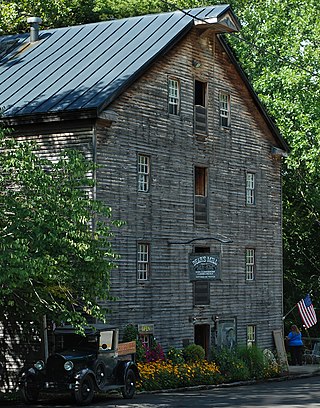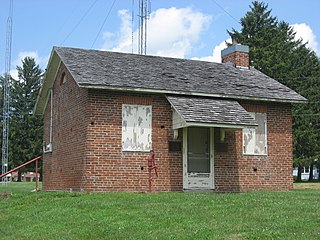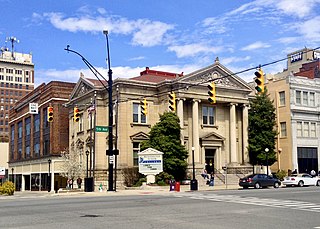
Greenville is a city in and the county seat of Darke County, Ohio, United States. It is located near Ohio's western edge, about 33 miles (53 km) northwest of Dayton. The population was 12,786 at the 2020 census.

Adams Township is one of the twenty townships of Darke County, Ohio, United States. The 2020 census found 3,343 people in the township.

The Cummins School is a historic former school building in Cincinnati, Ohio, United States. Built in 1871 in the neighborhood of Walnut Hills, it was later used as a model for the construction of other city school buildings.

The Darke County Courthouse, Sheriff's House and Jail are three historic buildings located at 504 South Broadway just south of West 4th Street in Greenville, Ohio. On December 12, 1976, the three buildings of the present courthouse complex were added to the National Register of Historic Places.

The National McKinley Birthplace Memorial Library and Museum is the national memorial to President William McKinley, located in Niles, Ohio. Also known as the McKinley Memorial Library, Museum & Birthplace Home, the memorial is a 232 by 136 by 38 ft marble monument with two wings. One wing houses the public McKinley Memorial Library, and the other features the McKinley Museum with exhibits about President McKinley and an auditorium.

Charles Henry Owsley (1846–1935) was an English-born American architect in practice in Youngstown, Ohio, from 1872 until 1912.

Holy Family Catholic Church is a historic Roman Catholic church in Wayne Township, Darke County, Ohio, United States. Located in the unincorporated community of Frenchtown, it houses an active congregation, and it has been accorded historic site status because of its well-preserved Gothic Revival architecture.

The Kenton Public Library is a historic building in downtown Kenton, Ohio, United States. One of 109 Carnegie libraries in Ohio, it was designed in 1905 by the architectural firm of Richards, McCarty and Bulford; Carnegie donated $20,000 to aid in its construction. An attempt to start a library in Kenton began in 1853, but over thirty years passed before one was actually begun. From 1886 to the opening of the Carnegie library, the library was housed in a business block on the city's central square. The library building is a one-and-one-half-story brick structure. An elevated foundation supports the rectangular structure, which is accessed from the street by a staircase.

Fort Jefferson was a fortification erected by soldiers of the United States Army in October 1791 during the Northwest Indian War. Built to support a military campaign, it saw several years of active fighting. Today, the fort site is a historic site.

The Anna Beir House, built in 1865 by Conrad Beir, is a historic two-story redbrick house located at 214 East 4th Street in Greenville, Ohio. Miss Anna Beir was a longtime art teacher in Greenville, who devised the house to the city of Greenville upon her death in the 1930s. It was used by the Greenville Art Guild for many years until a fire in the 1970s. A gallery in the Greenville Carnegie Library is named for Miss Beir. On April 11, 1977, the house was added to the National Register of Historic Places.

The Donovan Robeson House is a historic house in Greenville, Ohio, United States. Located along Fourth Street west of downtown, the Robeson House has been ranked as the city's most significant Queen Anne mansion.

The Studabaker-Scott House and Beehive School are two historic buildings near the city of Greenville in Darke County, Ohio, United States. Located along State Route 49 south of the city, both are unusually well-preserved remnants of the architecture of the middle third of the 19th century.

Bear's Mill is a historic gristmill near the city of Greenville in Darke County, Ohio, United States. Built in 1849, this watermill is the oldest existing industrial building in Darke County. Built by Manning Hart, a local contractor, the mill lies along Greenville Creek in southwestern Adams Township, midway between Greenville and the village of Gettysburg. It was purchased before its completion by Pennsylvanian Gabriel Bear, who completed and opened the mill in 1849. After his locally made millstones proved faulty, Bear travelled to France, where he acquired stones of a type regarded worldwide as of highest quality.

The Greenville Mausoleum is an Egyptian Revival structure in Greenville, Ohio, United States. Built in 1913, this historic mausoleum is built of concrete covered with courses of limestone, resting on a foundation of granite and covered with a roof of ceramic tiles. Among its most distinctive elements are the marble pillars, topped with capitals of the Doric order, that line the main entrance. The main portion of the interior, built in a basilican style with multiple aisles, contains approximately four hundred concrete and marble crypts, and the building's wings house individual family crypts. It is lit by twelve clerestory windows under the roofline.

The Carnegie Public Library at Huntington, West Virginia, formerly also known as the Cabell County Public Library, is a historic library building located on the northeast corner of Fifth Avenue and Ninth Street. It was the first public library in the county. It served the community as a library until 1980, when a new library opened across the street. The building currently houses the Huntington Junior College.

Immaculate Conception Catholic Church is a historic Catholic parish at Fulda in rural Noble County, Ohio, United States. Established in the 1840s among a group of German immigrants, it worships in a landmark building that dominates the surrounding community. The building has been named a historic site.

The historic Duluth Public Library is a former Carnegie library building at 101 West Second Street in Duluth, Minnesota, United States. It was constructed in 1902 as the first purpose-built facility of the Duluth Public Library. It was listed on the National Register of Historic Places in 1978 for its local significance in the themes of architecture and education. It was nominated for its Neoclassical architecture and association with early community education efforts.

The Civic Center is a mostly governmental district in downtown Cleveland, Ohio, that is home to the 1916 erected Cleveland City Hall Building. The 1925 Cleveland Public Library main branch, the 1976 massive Cuyahoga County Justice Center, the 419 foot Anthony J. Celebrezze Federal Building, the Federal Reserve Bank of Cleveland, the historic Cuyahoga County Courthouse, the Cleveland Public Hall, the Howard M. Metzenbaum U.S. Courthouse which abuts Public Square, and the city-owned greenspace Willard Park which is home to the Free Stamp.

The Delaware Public Library is a former public library in Delaware, Ohio. The building was funded by Andrew Carnegie and built in the neoclassical style. It opened to the public in 1906. The library's collection of books and volumes rapidly expanded during its operational history. By the 1970s, the Delaware Public Library started to run out of space. In 1984, a new public library was constructed, and Delaware County, Ohio started using the Delaware Public Library for office space. The building was tripled in size during a construction and restoration project that lasted from 1999 to 2001. The Delaware Public Library is currently used to house a number of Delaware County agencies, including the Delaware County Board of Commissioners.

The Main Library of the Columbus Metropolitan Library (CML) system is located in Downtown Columbus, Ohio, United States. The public library is the largest in the library system and holds approximately 300,000 volumes. It includes numerous rooms, including separate spaces for children, teens, an adult reading room, newspaper room, auditorium, gallery, gift shop, and a cafe. The third floor includes a computer lab and houses the Franklin County Genealogical & Historical Society.

























